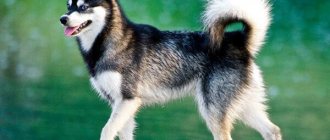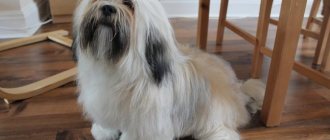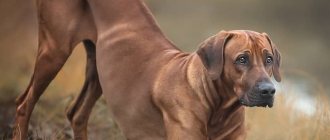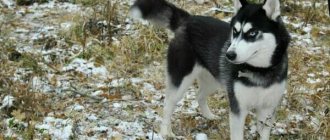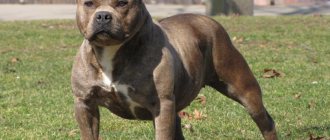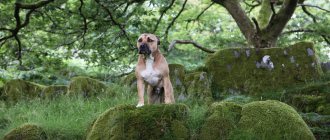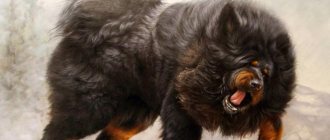General view of the breed standard
According to the requirements put forward by the International Association of Cynological Federations (FCI) , the Husky must be of medium size. This will allow her to exercise good maneuverability, provide lightness, freedom, grace and endurance. I think there is no need to explain for a long time why the Siberian breed should not be overweight and inactive.
Height and weight should be harmoniously balanced. According to the standard, the required height at the withers is as follows :
- For males - from 53 to 60 cm;
- In females - from 51 to 56 cm.
The weight proportional to the desired growth of Siberian Huskies should be within the following limits:
- For males – 20-28 kg;
- In females - 16-23 kg.
As you can see, males and females do not differ much in size, and this is completely normal. For example, RKF allows even identical parameters. But deviation from the standard leads to disqualification of the Siberian Husky at exhibitions and elimination when breeding the breed. Even Husky dogs should not be too large.
As for weight, the owner’s care plays a significant role - the breed itself is not prone to obesity. If your husky is not overfed and given balanced food, there is no need to worry about gaining extra pounds. Otherwise, the exhibition will only be a dream.
History of the breed
Siberian Husky began to attract the interest of professional dog handlers and breeders only at the beginning of the 20th century. At home - in the regions of the Far North of Russia - local residents used the ancestors of the husky to move across the tundra, go on remote hunts and to deer grazing areas. At that time, there was no such breed as the husky, and by the thirties of the twentieth century, the breeding of these northern dogs was considered unpromising in Soviet Russia, since they were replaced by technical means of transportation in the Far Eastern regions.
Residents of the northern regions of the United States, where gold and fur mining was in full swing, thought differently. In 1934, the breed was officially recognized there and received the name “Siberian Husky” in the registry. For the first time, representatives of the Chukchi and Eskimo sled dog breeds appeared in 1908 in Alaska. They later spread to other regions of America.
The northern husky began to return to Russian territory only in the 90s of the twentieth century, having first arrived here in 1995 from the Czech Republic and Belgium. And by the beginning of the 21st century, the number of purebred individuals had reached several hundred.
Subscribe to the newsletter and get a discount at the pet store “Lubimchik”
Thanks for subscribing!
Head
I would rather classify a large head as a disadvantage of the breed. However, being too light and giving the impression of sophistication also does not fit into the standard . In order to understand how proportional the head is, I recommend comparing the distance from the tip of the nose to the beginning of the skull and from the beginning of the muzzle to the back of the husky’s head. As for the width, ideally this breed should have medium width.
Now about what else you should pay attention to:
- Lips – no looseness! But pigmentation, according to the standard, should be there.
- The eyes – their shape in this breed is strictly almond-shaped. They are widely spaced and slightly oblique. An important point: excessive distance is not encouraged, as is close planting. As for the color, of course, those who have ever seen the breed first remember blue. However, huskies often have brown eyes, and even heterochromia - different colors in one individual. The breed even has a mosaic coloration, which is not a defect - when the same eye has different shades.
- Ears – this breed can boast of cute triangular thick ears with rounded ends, located at a relatively short distance from each other. I can say that they are located quite high on the head. Well furred. The standard for Huskies does not include ears tilting forward. According to the same standard, too wide ear cartilage is discouraged, as is excessive softness of the ears, their placement too wide in relation to each other.
- The nose - the transition to it from the forehead should, according to the standard, be clearly expressed. A too narrow and long nose is not welcome. The color of the earlobe depends on the color of the husky: a gray Siberian dog has a black earlobe, a black one has a yellowish-brown earlobe, a copper-red one has a liver hue, and a white one has a flesh-colored earlobe. The breed often showed a nose with a pink stripe or a completely snowy nose - the standard fully allows for this.
- As for the bite, it must certainly be scissor-shaped. All the rest are considered vices.
Recommendations for education and training
Any dog of this breed loves affection and attention. Therefore, during training, excessive praise should not be allowed. Moreover, manifestations of such attention and admiration on the part of strangers should be excluded. Huskies can deliberately provoke this behavior by getting underfoot and begging for treats. From the first days, the dog must understand the primacy of its owner and the need to obey his commands. Being a herd animal, where it is customary for the entire pack to obey the leader, the Siberian Husky will easily accept this state of affairs and will unquestioningly follow the wishes of the owner.
General training recommendations:
- during training, you cannot pick up the animal;
- communication with other dogs should be allowed;
- It is unacceptable to overload with one command for a long time; it is better to repeat these skills after some time or the next day;
- Fairness to your pet is one of the main conditions for successful training. It is necessary to show strictness for sabotaging given commands and generously reward with treats for zeal in their execution.
You should start training with the dog getting used to its own nickname, performing the most primitive commands: “Come to me!”, “Lie down!”, “Nearby!”, “Walk!”, “Sit!”
Neck, chest, back, tail
The breed boasts a proudly raised, slightly arched neck. When moving, it should stretch slightly. The length is ideally medium. I note that a Siberian dog should not have an overly long, short or thick neck - it will be inconvenient to carry a load with it.
The chest is designed in the spirit of the “golden mean” - strong, but not wide. I can call the ribs wide, but at the same time they should be as if flat on the sides. I would compare them to the shape of an arrow.
The Siberian dog has a straight, strong back. I note that the ideal average length is very well balanced: a back that is too short or too long would not be conducive to carrying cargo. No sagging or humping! The lower back should be narrower than the chest.
The tail's covering is somewhat reminiscent of a fox's. The landing is most often slightly above the top line. There is an upward bend in the shape of a sickle, but not always. Most often when the animal is very interested in something. In a state of rest, the tail is lowered down. I note that it should not fit tightly to the body, nor should it be tilted in one direction or another.
Husky care and maintenance
Siberian Huskies are very clean dogs. They do not smell and do not drool. There are only two points that the owner should pay special attention to.
The first is grooming. Dogs of this breed have a thin, dense undercoat that must be combed with a fine-tooth comb. Siberian Huskies shed twice a year, and during these periods they will need to be brushed several times a week.
The second point is related to the condition of the paw pads and claws. Nails should be trimmed regularly, and the condition of the pads should be closely monitored, as if cracks or lesions occur, the dog will experience severe pain.
Dogs of this breed are not afraid of cold weather and can rest right in the snow without any discomfort. But lying down for long periods of time is rare for huskies. They require frequent and active walks, games with other dogs and even with people. They show an active interest in toys of various types. Huskies energetically chase the ball and enthusiastically chew and fiddle with rubber toys.
Front and hind limbs
All four paws must be straight and parallel. The spacing between each other is moderate. This breed has elbows that fit quite tightly to the body. I draw your attention to the fact that the gap from the fingers to the elbows is greater than from the elbows to the withers.
This breed should ideally move quickly and easily. In turn, this means that when moving, the paws should under no circumstances turn out. Neither in nor out.
As for the paw pads, nature provides them with self-cleaning from snow. They are thick and hard. The paws are oval in shape and quite compact.
This breed has so-called dewclaws on its front paws. They are located behind the others, and Huskies are required mainly for scratching the muzzle.
The shoulder blades are directed back. In this case, the shoulder is not straight, but oblique - with the horizon it should make an angle of approximately 45 degrees. The muscles connecting the shoulder blades to the sternum should be well developed.
The breed is characterized by powerful hips. When running, the hind legs should give a good push. The hock joint is low. And this is normal, since in such a case the animal spends less muscle activity while running than it could.
The picture can be enlarged!
Description of the Siberian Husky breed
The most successful husky standards and characteristics of the breed are given using the example of dogs of British selection. This variety was not chosen by chance. Since the beginning of the registration and description of the Husky breed at the beginning of the 20th century, three directions have been developed:
- sled dogs - they are also called working dogs. Nowadays, they are used to deliver mail, take children on rides, and entertain tourists. These dogs are hardy, have moderation and proportionality in all parts of the body;
- racing dogs - although they are used in sleds, like their working relatives, they are used exclusively for the sporting interests of the owners. In this category of huskies there are two subtypes: dogs for skijoring (sport riding in small teams - up to 4 dogs in a team) and dogs for competitions in sixes and sleds with a large number of dogs. In the first version, the husky’s exterior is distinguished by greater height at the withers and muscular legs;
- show category husky, or show breed - this type was bred to participate in entertainment programs and dog shows. Two subgroups have been formed here - European and American type. American representatives of this breed look larger, with a massive chest; European relatives are more elegant and graceful, and the characteristics of the breed are more clearly visible in them.
Since there are still differences in the three categories of these dogs, British Huskies were chosen as a sample of the breed, so it is worth focusing on their description.
All types and categories of Siberian Husky are characterized by common features: a slightly shortened muzzle, dense coat and thick undercoat. All dogs are medium in size, with excellent running qualities and well-developed muscles. All types of dogs have a compact build. When looking at a husky from any angle, you immediately notice the ease of gait, smooth lines, proportional addition of the body, legs and head.
Features of the proportions of the Husky breed are as follows:
- the length from the stop to the back of the head is identical to the length from the stop to the nose;
- the length from the shoulder joint to the ischial tuberosity is greater than the height from the ground to the highest point at the withers.
Head
The husky's skull is absolutely proportional to the size of the dog's body. The head of Husky dogs is medium in size, slightly rounded closer to the ears and widened to the maximum in the eye area. Gradually the shape of the head narrows from the eye sockets towards the nose.
The dimensions of the Siberian Husky skull, from the stop to the extreme point of the occipital bone, are the same as the dimensions from the stop to the tip of the nose. The nose shape is round. The structure of the nasal tissue is elastic. The nostrils are well developed and open.
The eyes of Siberian Huskies are almond-shaped, with a distinct slanted cut, and the color varies from brown to blue.
The ears of Husky dogs are tightly set, medium in size and slightly rounded at the ends. Closer to the head, the ears have a wide base. Both ears are close to each other and point vertically upward.
Husky lips are characterized by the same pigmentation as on the nose. The structure of the lips is dense and massive, but the lips themselves are not thick.
The dentofacial apparatus is highly developed and has massive, but not long teeth with a characteristic scissor bite.
Neck
Siberian Huskies of any type - working, sporting or show dogs - have the same neck that stretches proudly above the body. The shape of the neck is slightly curved. When moving, especially with a load in a harness, the husky characteristically stretches its neck forward, forming an almost perfectly even straight axis with the entire body.
At the same time, the head also extends forward.
Frame
Since Husky dogs have a fairly large heart, it requires more space in the chest. This anatomical feature explains the narrow, but strong and deep chest.
The deepest point of the Husky's sternum is located just behind the elbow joint, on its horizontal axis.
Other features of the case are:
- wide arrangement of ribs;
- massiveness and strength of the rib bones;
- oblique type blade;
- The bevel angle of the scapula is no more than 45 degrees relative to the axis of the back;
- the shoulder joint is slightly beveled relative to the vertical axis;
- the line of the back, starting from the croup and ending with the top point of the withers, is absolutely straight; the husky's back appears to be very strong;
- back size - medium length.
The width of the back of purebred Siberian Huskies is also of medium size. The proportional ratio of length and width of the upper back gives the dog a compact appearance. This makes the exterior feel tightly built and durable.
Closer to the rear, a slight slope is noticeable in the croup area, which is necessary so that the dog can limit the pushing movements of the hind legs.
Front legs
The stance of the forelimbs complements the dense build of Siberian Huskies. The legs are positioned straight and parallel, at an even distance from each other.
If you look at the dog from the front, you can see that the front legs are slightly apart. Although the bones of Siberian Huskies are quite massive and strong, they are lightweight. The muscles of the front legs are moderately expressed.
Both elbow joints are evenly and tightly pressed to the body of the body. They are located straight, without internal turns and do not turn back either at rest or when moving.
The characteristic structure of all joints of the husky's forelimb is well-developed ligaments, cartilage tissue and muscle fibers. In addition to the strength and density corresponding to the Siberian Husky standard, almost all the tissues of the front paws are resilient and elastic.
The structure of the wrist joint is particularly flexible.
A slight slope is noticeable when viewed from the left or right at the metacarpus of the front paws. The shape of the paws of the forelimbs is regular oval, without distortion. The pads are dense and thick. A husky's front paws usually have dewclaws, which are necessary for grooming. But since they are often injured in working-type dogs, breed standards allow their removal.
When running fast, the front paws are noticeably brought forward, while the distance between the tracks of the front and hind limbs is practically absent. With free, slow running, the gap between them increases.
The toes of the front paw of a Siberian Husky have good fluff. There is some hair between them and the paw pads.
Hind legs
The stance of the Husky's hind legs is as straight as the front legs. They are also parallel and slightly spaced below when assessed from the front of the body.
The texture of the muscle tissue is strongly expressed on the hind legs. This is especially noticeable in the area of the knee, hip and hock joints.
Other features of the Husky standard in the hind limbs:
- tight articulation of the knee joint, with a slight angle;
- low position of the hock joint;
- massive hip joint, strong and durable.
All joints of the hind limbs have well-defined angles and slight slopes.
The paws of the husky's hind limbs are straight and of medium size. They do not turn back when moving. In a state of rest, the toes are tightly adjacent to each other. The shape of the hind legs is oval, with pronounced compactness. The pads are adapted for movement on loose snow and hard crust - they are durable, quite elastic and have a thickened sole.
Thanks to the anatomical structure and physiology of the hind and forelimbs, the Siberian Husky has an even gait and uniform running in a characteristic gait style. The dog can also move at a moderate trot. If necessary, speed develops quickly, with the hind paw moving after the front limb of the same name.
The hind limbs are evenly pubescent; there is dense undercoat even between the toes and paw pads.
Tail
Northern Huskies have a tail located below the horizontal axis of the upper back. It has a fox-like shape, with a rich coat of fur. In normal condition, the tail is carried slightly raised above the level of the upper back or may be lowered. During the active or alert stage, the tail may be curled slightly to one side or forward, taking on a sickle shape.
Wool
These dogs, resistant to low temperatures, are characterized by a thick and dense coat - it allows them to maintain a stable body temperature, preventing the animal from freezing at rest or in strong cold winds.
The Husky's coat is of moderate length, with a dense and dense undercoat. It, like wool itself, has a soft, pliable structure. During shedding, there is practically no undercoat on the body. The fur is straight, smooth and close to the body.
The Northern Husky's coat color ranges from completely white to perfectly black. The standards allow the presence of marks in the head area.
This is usually a mask-shaped color on the animal's face, the opposite shade of the main coat color. As a rule, such a mask has light colors.
The standards and characteristics of dogs of this breed allow several types of coat color:
- black and white color, with color proportionality 50/50. In the lower part of the body with this color, a white tint predominates, and on the top - black. Often the white fill starts from the muzzle. This is one of the most common colors - with a black nose and eye rims of the same color;
- Gray Coated Husky - A common Husky color, with an even shade and a silvery undercoat. The color of the nose and the lining of the eye sockets is purely black;
- silver coat color is less common and is characterized by the presence of white or silver undercoat and light gray wool;
- Agouti color is characterized by uneven filling of the coat and undercoat. The color range of this color is from black to gray, sometimes with spots of a reddish tint. The muzzle has a dark mask;
- The wolf color of the Husky is notable for its dark black color and red patches in the eye area and behind the ears.
Less common colors are absolutely black and absolutely white. A little more often at exhibitions you can see Siberian huskies of fawn, copper, red color, as well as Isabella and sable.
During the process of age-related molting, the color of a husky may change. More often it changes only the shade, becoming lighter or darker.
Size
The following husky sizes correspond to breed qualifications:
- Male huskies can reach up to 54-60 cm at the highest point of the withers;
- The height of bitches of this breed should not exceed 51-56 cm.
These dogs are characterized by proportionality of body weight and height. The average weight of males, according to the standards established by dog handlers for these dogs, is up to 20.5-28 kg. In females the weight is 15.5 kg - 23 kg. The weight of animals depends on the type of breed - working, sporting or exhibition. In the latter case, body weight may be greater. The slenderest are the sporting huskies.
Knitting legs (2 parts).
Knitting the body and legs of a husky dog has many similarities with knitting similar parts of a bull terrier.
We start knitting with white yarn.
1st row:
Close 6 single crochet stitches (hereinafter referred to as single crochet) into a sliding amigurumi ring (6).
2nd row:
(1 increase) – repeat 6 times, i.e. to the end of the row (12).
3rd row:
(1 tbsp, 1 increase) – 6 times (18).
4th row:
(2 tbsp, 1 increase) – 6 times (24).
We fasten the thread with a gray-blue color. The white thread can be cut.
Row 5 (gray-blue yarn):
24 st. b/n.
We fasten the thread with a light gray color. The blue-gray thread can be secured and cut.
From the 6th row we knit a piece with light gray yarn.
6th row:
2 decreases, 6 tbsp, 4 decreases, 6 tbsp (18).
7th row:
1 decrease, 5 tbsp, 3 decreases, 5 tbsp (14).
8th row:
5 tbsp, 2 decreases, 5 tbsp (12).
9-10 rows:
12 st. b/n.
11th row:
(5 tbsp, 1 increase) – 2 times (14).
Row 12:
(6 tbsp, 1 increase) – 2 times (16).
Row 13:
16 stitches + 3 stitches so that the last stitch is on the inside of the foot.
We knit the second leg in the same way, but do not cut off the working thread.
We fill both paws. We continue knitting the second foot: cast on 2 chain stitches, attach the first foot using a connecting post.
Let's move on to knitting the dog's body.

